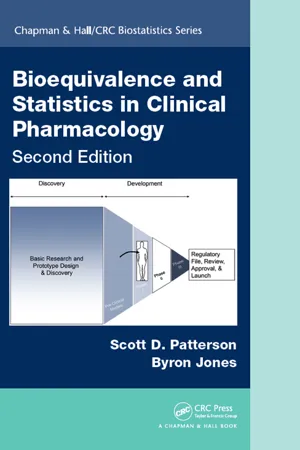
- 434 pages
- English
- ePUB (mobile friendly)
- Available on iOS & Android
Bioequivalence and Statistics in Clinical Pharmacology
About this book
Maintaining a practical perspective, Bioequivalence and Statistics in Clinical Pharmacology, Second Edition explores statistics used in day-to-day clinical pharmacology work. The book is a starting point for those involved in such research and covers the methods needed to design, analyze, and interpret bioequivalence trials; explores when, how, and why these studies are performed as part of drug development; and demonstrates the methods using real world examples.
Drawing on knowledge gained directly from working in the pharmaceutical industry, the authors set the stage by describing the general role of statistics. Once the foundation of clinical pharmacology drug development, regulatory applications, and the design and analysis of bioequivalence trials are established, including recent regulatory changes in design and analysis and in particular sample-size adaptation, they move on to related topics in clinical pharmacology involving the use of cross-over designs. These include, but are not limited to, safety studies in Phase I, dose-response trials, drug interaction trials, food-effect and combination trials, QTc and other pharmacodynamic equivalence trials, proof-of-concept trials, dose-proportionality trials, and vaccines trials.
This second edition addresses several recent developments in the field, including new chapters on adaptive bioequivalence studies, scaled average bioequivalence testing, and vaccine trials.
Purposefully designed to be instantly applicable, Bioequivalence and Statistics in Clinical Pharmacology, Second Edition provides examples of SAS and R code so that the analyses described can be immediately implemented. The authors have made extensive use of the proc mixed procedures available in SAS.
Frequently asked questions
- Essential is ideal for learners and professionals who enjoy exploring a wide range of subjects. Access the Essential Library with 800,000+ trusted titles and best-sellers across business, personal growth, and the humanities. Includes unlimited reading time and Standard Read Aloud voice.
- Complete: Perfect for advanced learners and researchers needing full, unrestricted access. Unlock 1.4M+ books across hundreds of subjects, including academic and specialized titles. The Complete Plan also includes advanced features like Premium Read Aloud and Research Assistant.
Please note we cannot support devices running on iOS 13 and Android 7 or earlier. Learn more about using the app.
Information
Part III
Clinical Pharmacology
8
Clinical Pharmacology Safety Studies
Introduction
Table of contents
- Cover
- Half Title
- Series Page
- Title Page
- Copyright Page
- Dedication
- Table of Contents
- List of Figures
- List of Tables
- Preface to the Second Edition
- I Bioequivalence and Biopharmaceutical Development
- II Special Topics in Bioequivalence
- III Clinical Pharmacology
- IV Vaccines and Epilogue
- V Bibliography
- Index